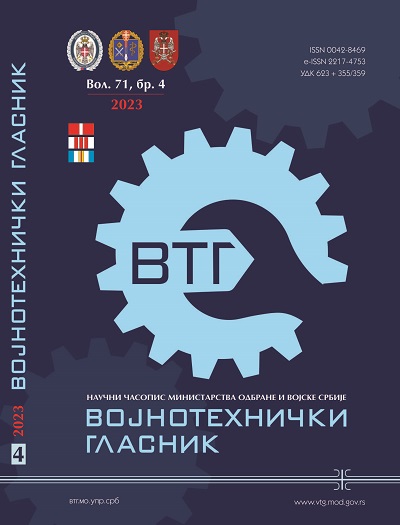Povećanje efikasnosti guseničnog vozila optimizacijom prenosnih odnosa i strategije promene stepena prenosa
Sažetak
Uvod/cilj: Gusenična vozila imaju značajnu ulogu u različitim oblastima, od borbenih operacija do građevinske industrije i poljoprivrede. Rad je fokusiran na povećanje efikasnosti guseničnih vozila optimizacijom prenosnih odnosa i strategije promene stepeni prenosa, uz zadržavanje zahtevanih performansi.
Metode: Proces optimizacije uključuje genetski algoritam za određivanje optimalnih prenosnih odnosa, uzimajući u obzir ograničenja performansi. Osim toga, rad uvodi algoritam za optimizaciju promene stepena prenosa koji ima za cilj maksimizaciju ekonomičnosti vozila, uz obezbeđivanje validnog poređenja dva seta prenosnih odnosa.
Rezultati: Optimizacija prenosnih odnosa dovodi do značajnih smanjenja potrošnje goriva, što je uzrokovano efikasnijim radom motora sa unutrašnjim sagorevanjem. Pored toga, optimizovana strategija promene stepena prenosa dodatno povećava efikasnost, što je dovelo do smanjenja potrošnje goriva većem od 12%.
Zaključak: Predstavljen je sistemski pristup optimizaciji odnosa prenosa i strategija promene stepena prenosa kod guseničnih vozila. Rezultati pokazuju značajna poboljšanja u efikasnosti vozila i smanjenje potrošnje goriva bez ugrožavanja ostalih kritičnih parametara performansi vozila.
Reference
Achour, H. & Olabi, A.G. 2016. Driving cycle developments and their impacts on energy consumption of transportation. Journal of Cleaner Production, 112, pp.1778–1788. Available at: https://doi.org/10.1016/j.jclepro.2015.08.007.
Ahssan, M.R., Ektesabi, M. & Gorji, S. 2020. Gear ratio optimization along with a novel gearshift scheduling strategy for a two-speed transmission system in electric vehicle. Energies, 13(19), p. 5073. Available at: https://doi.org/10.3390/en13195073.
Bhatia, V. 2015. Hybrid tracked combat vehicle. In: 2015 IEEE International Transportation Electrification Conference (ITEC). Chennai, India, pp.1–23, August 27-29. Available at: https://doi.org/10.1109/ITEC-India.2015.7386862.
Eckert, J.J., Corrêa, F.C., Santiciolli, F.M., Costa, E.d.S., Dionísio, H.J. & Dedini, F.G. 2016. Vehicle gear shifting strategy optimization with respect to performance and fuel consumption. Mechanics Based Design of Structures and Machines, 44(1-2), pp. 123–136. Available at: https://doi.org/10.1080/15397734.2015.1094669.
Eckert, J.J., da Silva, S.F., de Menezes Lourenço, M.A., Correa, F.C., Silva, L.C. & Dedini, F.G. 2021. Energy management and gear shifting control for a hybridized vehicle to minimize gas emissions, energy consumption and battery aging. Energy Conversion and Management, 240, p. 114222. Available at: https://doi.org/10.1016/j.enconman.2021.114222.
Han, X., He, H., Wu, J., Peng, J. & Li, Y. 2019. Energy management based on reinforcement learning with double deep Q-learning for a hybrid electric tracked vehicle. Applied Energy, 254, p. 113708. Available at: https://doi.org/10.1016/j.apenergy.2019.113708.
Hardenberg, H.O. & Buhl, H. 1982. The MERCEDES-BENZ OM 403 VA-A Standard Production, Compression-Ignition, Direct-Injection Multifuel Engine. SAE transactions, 91, pp. 93–120 [online]. Available at: https://www.jstor.org/stable/44631933 [Accessed: 20 August 2023].
Jimenez-Espadafor, F.J., Marín, J.J.R., Villanueva, J.A.B., García, M.T., Trujillo, E.C. & Ojeda, F.J.F. 2011. Infantry mobility hybrid electric vehicle performance analysis and design. Applied energy, 88(8), pp. 2641–2652. Available at: https://doi.org/10.1016/j.apenergy.2011.02.010.
Milićević, S. & Muždeka, S. 2021. Modelling and performance analysis of the BVP M-80A hybrid drive. Vojnotehnički glasnik/Military Technical Courier, 69(1), pp. 64–87. Available at: https://doi.org/10.5937/vojtehg69-28232.
Milićević, S.V. & Blagojević, I.A. 2022. Component sizing and energy management for a series hybrid electric tracked vehicle. Vojnotehnički glasnik/Military Technical Courier, 70(4), pp. 877–896. Available at: https://doi.org/10.5937/vojtehg70-39762.
Milićević, S.V. & Blagojević, I.A. 2023. Theoretical Model of High-Speed Tracked Vehicle General Motion. FME Transactions, 51(3), pp. 449–456. Available at: https://doi.org/10.5937/fme2303449M.
Milićević, S.V., Blagojević, I.A. & Muždeka, S.R. 2021. Advanced rule-based energy management for better fuel economy of hybrid electric tracked vehicle. FME Transactions, 49(3), pp. 711–718. Available at: https://doi.org/10.5937/fme2103711M.
Qin, Z., Luo, Y., Zhuang, W., Pan, Z., Li, K. & Peng, H. 2018. Simultaneous optimization of topology, control and size for multi-mode hybrid tracked vehicles. Applied energy, 212, pp. 1627–1641. Available at: https://doi.org/10.1016/j.apenergy.2017.12.081.
Randive, V., Subramanian, S.C. & Thondiyath, A. 2019. Component Sizing of Single and Dual Drive Series Hybrid Electric Powertrain for Military Tracked Vehicles. In: 2019 IEEE Vehicle Power and Propulsion Conference (VPPC). Hanoi, Vietnam, pp.1–6, October 14-17. Available at: https://doi.org/10.1109/VPPC46532.2019.8952308.
Randive, V., Subramanian, S.C. & Thondiyath, A. 2021. Design and analysis of a hybrid electric powertrain for military tracked vehicles. Energy, 229, p. 120768. Available at: https://doi.org/10.1016/j.energy.2021.120768.
Zhang, B., Guo, S., Lv, Q., Zhang, X., Ouyang, M. & Teng, L. 2021. Quantitative analysis of the energy saving mechanism of a hybrid electric tracked vehicle by an analytical method. Energy Conversion and Management, 237, p. 114067. Available at: https://doi.org/10.1016/j.enconman.2021.114067.
Zou, Y., Sun, F., Hu, X., Guzzella, L. & Peng, H. 2012. Combined optimal sizing and control for a hybrid tracked vehicle. Energies, 5(11), pp. 4697–4710. Available at: https://doi.org/10.3390/en5114697.
Sva prava zadržana (c) 2023 Stefan V. Milićević, Ivan A. Blagojević

Ovaj rad je pod Creative Commons Autorstvo 4.0 međunarodnom licencom.
Vojnotehnički glasnik omogućava otvoreni pristup i, u skladu sa preporukom CEON-a, primenjuje Creative Commons odredbe o autorskim pravima:
Autori koji objavljuju u Vojnotehničkom glasniku pristaju na sledeće uslove:
- Autori zadržavaju autorska prava i pružaju časopisu pravo prvog objavljivanja rada i licenciraju ga Creative Commons licencom koja omogućava drugima da dele rad uz uslov navođenja autorstva i izvornog objavljivanja u ovom časopisu.
- Autori mogu izraditi zasebne, ugovorne aranžmane za neekskluzivnu distribuciju rada objavljenog u časopisu (npr. postavljanje u institucionalni repozitorijum ili objavljivanje u knjizi), uz navođenje da je rad izvorno objavljen u ovom časopisu.
- Autorima je dozvoljeno i podstiču se da postave objavljeni rad onlajn (npr. u institucionalnom repozitorijumu ili na svojim internet stranicama) pre i tokom postupka prijave priloga, s obzirom da takav postupak može voditi produktivnoj razmeni ideja i ranijoj i većoj citiranosti objavljenog rada (up. Efekat otvorenog pristupa).

